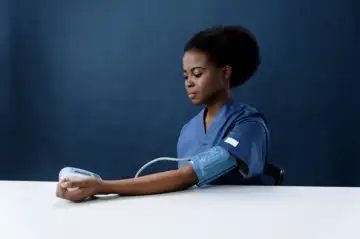Hypertension or and low blood pressure are both so intricately linked with heart health that everyone who has ever visited a doctor for any illness has probably had to get their BP checked.
But the big difference between getting your BP checked at a hospital or clinic and doing it yourself at home (which has become quite the norm since the COVID-19 pandemic hit) is that while the nurses and doctors know how to read the specs right, most of the rest of us don’t. I’ll admit it: The first time I used a digital blood pressure machine at home, I almost gave myself a mini panic attack. The reading flashed a number I thought was way too high, and instantly my heart began to race. Ten minutes (and a few deep breaths) later, when I checked again, the numbers had dropped. That’s when I realised something important: blood pressure isn’t just about numbers, it’s about context.
We Indians are increasingly buying affordable, portable BP monitors, and that’s a good thing. They’re simple, accessible, and cost anywhere between INR 1,000-2,500. And with the new on medical equipment, perhaps BP monitors will get even cheaper. But even if the monitors get cheaper, most of us don’t know how to read them correctly, or what the numbers even mean. That’s where confusion (and unnecessary stress) sets in.
So, let’s decode it together.
What Do Those Blood Pressure Numbers Really Mean?
A reading has two numbers:
- Systolic pressure (the top number): The pressure in your arteries when your heart beats.
- Diastolic pressure (the bottom number): The pressure when your heart rests between beats.
For example, if your reading says 120/80 mmHg, that means your systolic is 120 and your diastolic is 80. According to the (AHA) and (ICMR) guidelines, here’s how it breaks down:
- Normal: Less than 120/80 mmHg
- Elevated: 120-129 systolic and less than 80 diastolic
- High BP (Hypertension Stage 1): 130-139 systolic or 80-89 diastolic
- Hypertension Stage 2: 140 or higher systolic, or 90 or higher diastolic
- Hypertensive crisis: Over 180/120 mmHg (seek medical help immediately)
Why Stress (And Your Mood) Matters
Here’s where it gets interesting. isn’t fixed. It changes throughout the day depending on your activity, mood, and even posture. Personally, I’ve noticed that when I’m anxious, running late, or just thinking too much, my BP reading shoots up. After a short walk, meditation, or a good night’s sleep, it drops again.
Science backs this. Stress triggers your body’s “fight-or-flight” response, releasing adrenaline and cortisol. This temporarily raises your heart rate and blood pressure. That’s why doctors often check your pressure more than once during a visit to rule out “white coat hypertension,” a phenomenon where people’s BP spikes simply because they’re nervous in a clinic.
So, if you find your readings vary, don’t panic. One single high number isn’t always a cause for alarm. What matters is the pattern over time.
 Photo Credit: Pexels
Photo Credit: Pexels
How To Measure Blood Pressure Correctly At Home
Now, let’s talk technique. Portable BP machines are great, but only if you use them properly. Here are some tips to make sure your readings are accurate:
- Sit comfortably. Rest in a chair with your back supported, feet flat on the floor, and legs uncrossed.
- Rest before measuring. Sit quietly for five minutes before taking a reading.
- Arm position matters. Place your arm on a flat surface at heart level. The cuff should fit snugly on your bare upper arm.
- Avoid stimulants. Don’t measure right after tea, coffee, smoking, or exercise. These can raise readings temporarily.
- Breathe normally. Don’t talk or hold your breath while the machine is working.
- Take multiple readings. Record 2-3 readings, a minute apart, and note the average.
- Track it. Write down your results with date and time, or use a BP monitor that syncs to an app. This helps your doctor see trends.
These simple steps can make the difference between an alarming “false high” and an accurate, useful reading.
Why Regular Blood Pressure Monitoring Helps
High blood pressure, or hypertension, is often called a “silent killer” because it usually has no symptoms but increases your risk of heart disease, stroke, and kidney problems. In India, nearly one in three adults is estimated to have hypertension.
The good news? Regular home monitoring can catch early changes, giving you and your doctor time to act. Lifestyle adjustments like reducing salt, eating more fruits and vegetables, walking daily, and managing stress can bring numbers down before medication becomes necessary.
Decoding Your BP Numbers Without Fear
Here’s my personal mantra: Numbers are information, not judgments. If your reading is slightly high one day, don’t spiral into worry. Instead, check your posture, think about what you ate or drank, reflect on your stress levels, and try again later.
I’ve found that keeping a calm mindset, practising slow breathing, and even listening to music helps me get a more “real” picture of my . Over time, the numbers tell a story of habits, health, and progress.
Blood pressure monitors are not just gadgets; they’re tools for self-awareness. Used correctly, they empower us to take charge of our health instead of fearing the unknown. So, the next time you strap that cuff around your arm, remember: you’re not just chasing numbers, you’re decoding your body’s signals. And trust me, once you learn how to read them right, you’ll feel less panic, more control, and a lot more peace of mind.
Disclaimer: This content including advice provides generic information only. It is in no way a substitute for a qualified medical opinion. Always consult a specialist or your own doctor for more information. NDTV does not claim responsibility for this information.
References:
American Heart Association (AHA). Understanding Blood Pressure Readings.
Indian Council of Medical Research (ICMR). Guidelines for Management of Hypertension in India.
World Health Organization (WHO). India: Hypertension Fact Sheet.
